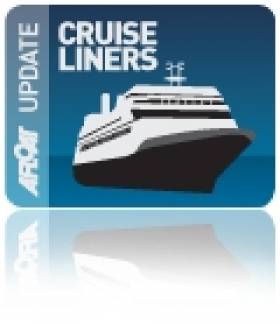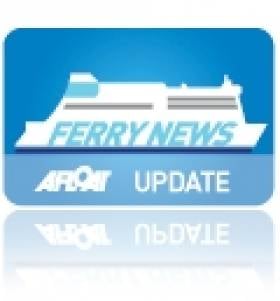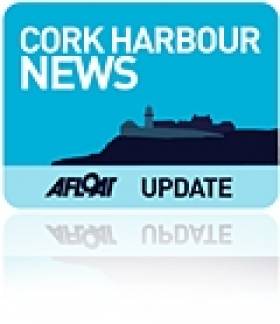Displaying items by tag: Ringaskiddy Ferry Terminal
Cruiseship Berths at Cork Harbour’s Ferryport Terminal
#CruiseFerryBerths - Brilliance of the Seas departed Cobh in the afternoon followed by Discovery this evening, the latter notably had berthed at Ringaskiddy Ferry Terminal as distinct to docking at the adjacent deep water berth, writes Jehan Ashmore.
The Royal Caribbean Lines 90,000 tonnes 'Radiance' class Brilliance of the Seas had called to Cobh's dedicated 'cruise' terminal before she headed for Klasvik, Norway. As for Discovery she is bound for St. Mary's, the capital of the Scilly Islands.
Normally, when more than one cruise caller arrives the same day, the Ringaskiddy deepwater berth that mostly accommodates large ocean-going cargoships also caters for cruiseships that has included the famous 'Cunarder' QE2.
Discovery of 19,900 tonnes is on charter to Cruise & Maritime Voyages, she had berthed at the Ringaskiddy Ferry Terminal ro-ro berth jetty. It is at this berth that Brittany Ferries cruiseferry, Pont-Aven of 41,700 tonnes, making her twice the size of the cruiseship, calls from Roscoff on Saturdays. She has a capacity for 2,400 passengers and like cruiseships, she features a pool.
The intimate 700 passenger Discovery is a small vessel in today's cruiseship market. She was launched as Island Venture in 1971 and is the surviving sister of a pair of almost 20,000 tonnes vessels built for Norwegian based Flagship Cruises.
The German built sisters were better known during careers for Princess Cruises as the Island Princess and Pacific Princess, which saw them appear in the popular US TV series the 'Love Boat' during the 1970's. The latter sister was scrapped this year.
On completion of this current cruise, Discovery departs Bristol (Avonmouth) on a 14-night cruise to the Azores and Madeira. It is understood that following her final cruise for CMV in October she is due to be sold.
IMERC’s Inaugural Conference 2012
#IMERC CONFERENCE - The recently established Irish Maritime and Energy Resource Cluster (IMERC) which is to promote the country as a world-renowned research and development location, is to host next month its inaugural conference entitled 'Maritime Geostrategic Thinking for Ireland'.
Minster for Marine, Simon Coveney T.D. will address the conference at the National Maritime College of Ireland (NMCI), Ringaskiddy, Co, Cork which is to be held on Friday 9th March.
In addition to keynotes speakers addressing the conference are Glenn Murphy (IMDO), Commodore Mellett of the Naval Service, Anthony Gurnee from Ardmore Shipping, Helen Noble, Head of Maritime Law at Matheson Ormsby and Prentice and Professor D John Mangan from the University of Newcastle.
Below is a programme schedule of the conference and additional information and link.
Session 1: Fighting recession by supporting an export led economy
Session 2: Building maritime security capability in support of economic development
Session 3: Future of Maritime Ireland
Session 4: IMERC Industry Engagement
To make a booking and receive further details on the conference contact IMERC Tel: (021) 433 5717 or by clicking HERE.
IMERC is based on the campus grounds of NMCI which is located between the Naval Service Base on Haulbowline Island and the neighbouring ferryport in Ringaskiddy.
Under phrase 1 of IMERC's campus development plans, it aims for the construction of the UCC National Beaufort Centre by May 2013. Phase 2 of the campus is for an extended maritime and energy science and commercial park located on the adjacent Port of Cork owned landbank.
Restructured Fastnet Line Reduce Year Round Service to Seasonal Schedule
The discontinued winter sailing schedule for this year is also expected not to be repeated during October 2012-March 2013. Fastnet Line's decision to make the Celtic Sea route into a shoulder season and summer only service follows a similar path taken by Stena Line which withdrew Dun Laoghaire-Holyhead (HSS) sailings in mid-September, for report click here. The central corridor route is due to reopen sometime in April or May 2012.
Cork City and County council and Kerry County council have provided €700,000 to support Fastnet Line and yesterday they announced an additional €150,000 in co-funding for the period of the examinership. In order to stabilise finances the ferry company are to radically reduce passenger capacity of the Julia (see photo) from 1,500 down to 950. This is in line with the capacities of the Julia serving 'night' sailings.
She has a crew predominately from Eastern Europe and Irish and UK deck officers. The Bermuda flagged, Hamilton registered vessel is currently berthed at Ringaskiddy Ferry Terminal, Cork Harbour. At 154m she is the largest ferry to date capable of berthing in the limited confines of the swing basin in Swansea and with a draft of 5.8m in a port which is subject to a large tidal range on the Bristol Channel.
Operating costs on the 10 hour service has been severely hampered by continuing increases to world oil prices. From the year 2010 to this year, fuel costs rose by 27% and almost 50% from the original budget of 2009. The company claims that each crossing amounts to €18,560 alone in fuel costs.
Fastnet Line to date has carried 150,000 customers, of which 75% have originated from the UK market, generating on average €350 per person (€40m approx) exclusive of fare and on-board spend. This crucial market is core to the success of the company's direct 'gateway' route to scenic south-west Ireland, with Swansea connected to the M4 motorway linking midland population centres and London. The operator claims a saving of 600km driving based on a round trip compared to using rival ferries running on routes to Rosslare from Pembroke Dock and Fishguard.
Since the reinstatement of the service in March 2010, after Swansea Cork Ferries pulled the Superferry (photo) off-service in 2006, the loss to tourism generated revenue on both sides of the Celtic Sea was estimated to be £25m per annum according to the Welsh Assembly and a similar figure recorded in the Cork and Kerry region.
The company also outlines the reduction in carbon emissions saved from operating the only direct service specifically connecting the regions of Glamorgan and Munster. Some 500,000 freight miles alone were saved in the Welsh region since the service started instead of using alternative route running from Pembrokeshire ports.
- Cork Harbour
- west cork
- port of Cork
- Celtic sea
- Cork City council
- Fastnet Line
- M.V. Julia
- M4 motorway
- Kerry
- Irish High Court
- Stena Line
- Ports and Shipping News
- cork harbour news
- Ferry news
- HSS
- Welsh Assembly
- Cork County Council
- Associated British Ports
- ABP
- Ringaskiddy Ferry Terminal
- M.V. Superferry
- SwanseaCork Ferries
- SCF
- Fastnet Line Group
- Kerry County Council
- HSS Dun LaoghaireHolyhead sailings
- Glamorgan
- Munster regions
- Bristol Channel
- Bristol Channel tidal range
- Swansea Port
- Irish tourism sector
- Pembroke DockRosslare
- FishguardRosslare
Brittany Ferries End of Season Sailings
Pont-Aven's final end of season sailing will be departing Ringaskiddy on Saturday (29th) at 15.00hrs and she is due to arrive at her homeport of Roscoff at 06.00hrs local time.
To confirm sailing schedule including next season starting March 2012 click HERE and for sailing update click HERE.
The €100m luxurious ferry was built in Germany in 2004 and she entered service that year on the three-route roster linking Ireland on the 14-hour overnight weekend sailings in addition to serving on French-UK and UK-Spainish routes.
Uniquely she is the only ferry operating in Irish waters with a swimming pool which is enclosed on the upper deck. Of the various facilities, services and entertainment, they may vary depending on the date and time of year.
Take a View From the Bridge
In the evening the Cork Corona Film Festival will hold a fundraiser themed the 'Amazing Cork Maritime Experience' at the NMCI from 5pm onwards.
Also in Ringaskiddy, at the Deepwater Quay, Fastnet Lines' 22,000 tonnes Julia will be open to the public between 11am to 3pm. This will allow those to tour the facilities of the 1,500 passenger/325 vehicle capacity ferry which has operated the year round Cork-Swansea route since last year.
To enable visitors to visit the events spread across the world's second largest natural harbour, a free shuttle-ferry service connecting Ringaskiddy, Monkstown,Cobh, Aghada and Crosshaven will be operating on the day. The ferry service is sponsored by the Port of Cork Company and National Maritime College of Ireland (NMCI).
- port of Cork
- Cork Harbour Open Day
- NMCI
- Fastnet Line
- National Maritime College of Ireland (NMCI)
- Ports and Shipping News
- Cork Harbour News
- Port of Cork Company
- Ferry news
- Portsand Shipping News
- Irish nautical college
- MVJulia
- Ringaskiddy Ferry Terminal
- CorkSwansea ferry route
- Cork Corona Film Festival
































































